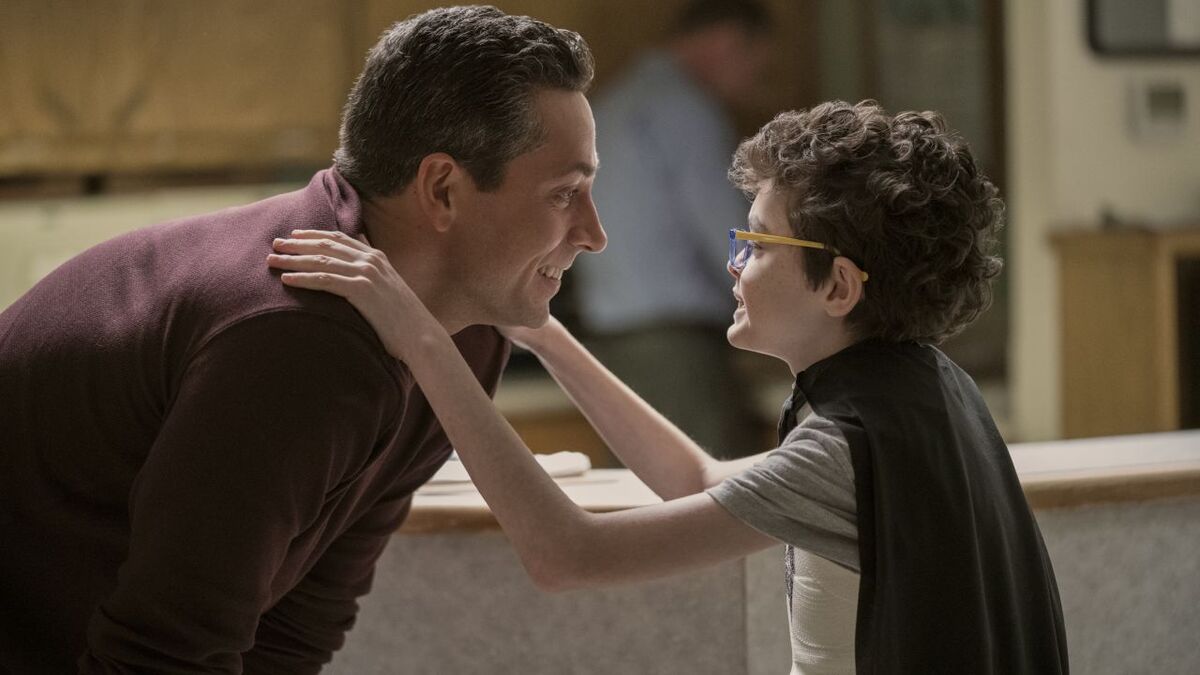
Much like other genre fare dealing in unexpected isolation (CBS’s short-lived, post-nuclear war drama Jericho, and more notably, Lost, which UtD cribs its title card from), the show’s premise provides much to puzzle over and investigate over the long haul. Is the barrier a government super-weapon? The result of a terrorist attack? Is it even terrestrial in origin? While the macro questions will become more prominent later down the road, the goldfish bowl itself allows for some nifty glory shots in the pilot, including the aforementioned vehicles getting crumpled like they’ve just been punched by The Hulk’s invisible twin brother, as well as some subtler, more disturbing bits, like seeing a roaring fire engine screaming to a halt in front of the divide, without a single sound being heard from inside the dome.
But the limitations won’t start to pop-up until after the initial shock wears off, once things have settled down, and stories have to start developing from within the town, and it’s then that the show’s viability will depend on the strengths of these characters that have found themselves unwilling participants in a massive phenomena. The cast is introduced gradually throughout the hour, with the main characters appearing before the lid is sealed, and the supporting players filtering in as everyone reacts to the sudden change in city limits. “Pilot” moves efficiently, and sets up the status quo quickly, introducing its main hook before the first act is up, and laying out its implications before the end of act two. “Whatever it is, it cut off the roads,” says Linda (Natalie Martinez), the perky young deputy, now quarantined from her firefighter husband (whose name is Rusty, by the way). “Not just the roads…the whole town,” responds the lackadaisical but sturdy Sheriff Duke (Lost’s Jeff Fahey). “We’re trapped,” drives home two-faced councilman Jim Rennie (Dean Norris, who’s a long way from Albuquerque).
There’s not a whole lot of room for nuance in this first hour, as the most surprising character beat involves the stock childhood-romance plot taking a seriously dark turn early, but everything else is pretty by the numbers. Barbie projects brooding mystery, but you know there’s a good guy behind the exterior that only intrepid local reporter Julia Shumway (Rachelle Lefevre) can get to the heart of. A local radio jock looks to capitalize on suddenly having the loudest mouthpiece in town, and a couple’s diabetic daughter is a ticking time bomb. That the couple is same-sex, interracial, and of mixed eye prescription (gasp!) adds a potentially awesome wrinkle to the old standard, just as Norris proves mighty captivating, getting his own chance to break bad, and play a bureaucrat who might be involved (nay, responsible) for what’s happened to Chester’s Mill.
While not strikingly written, and largely uneven in terms of performances (Alexander Koch as Junior, and Colin Ford as the plucky Joe are awful in some scenes, yet perfectly competent in others), “Pilot” succeeds all the same, thanks in large part to the guiding hand of comic book veteran (and occasional Lost writer) Brian K. Vaughn. The hour’s rapid pacing and mostly charming brushes with cheesiness are the byproduct of a guy who knows how to write stories that commit to the outlandish, and keep things moving. It was often times easier to imagine this episode as being an adaptation of Vaughn’s own work (particularly, Y: The Last Man), instead of anything by King.
As such, Under the Dome has its fair share of goofy bits during the first hour (the effects shots are great, but when actors get involved in them the illusion breaks, hard), but also offers a lot more to chew on then just a bunch of question marks. Sci-fi and network television have a checkered past with one another (including classics like Star Trek, which the show references), as for every Lost, and Fringe that comes around, there are a dozen The Events (games of keep away between the audience, and meaningful answers) and Heroes (heavily premised genre programs that have promise far exceeding what they can actually deliver). Here though, the appearance of the dome might just be the initial incident that kicks off a series about a small town being put through an unthinkable trial, and how the community’s true self comes to the surface while under a five-mile wide microscope. If it can do that, then spending 13 hours inside Chester’s Mill might not be a horrifying experience in the slightest.
- Stray Thoughts and Spoilers
-I’d be interested to hear what experts on the book, and more devoted King readers make of the first episode, and how faithful the adaptation is. From what I understand, Under the Dome the novel is King to a T: full of great characters, tons of atmosphere, but burdened by a whiffed ending. For the record, my literary experience with him only includes a few short stories, The Gunslinger, and 11/22/63, the ending to both I enjoyed well enough.
-The pilot was directed by Niels Arden Oplev, the man behind the original Swedish version of The Girl with the Dragon Tattoo film. I suppose his experience with that series helped with the filming of Renny Junior’s captivity scenes with Angie, which I can’t say I’m jazzed about. When even HBO can’t make sustained torture and imprisonment plots watchable, I don’t know if I’ll have a whole lot of patience for this story, but it’s early days.
-Despite the lack of color to the dialogue, I like how the show is sprinkling in some political and social elements. Norris and Fahey staring each other down was going to be great no matter what, but the conflict between politicians and law enforcement amidst a crisis is a rich one. Too bad Captain Frank Lapidus blows a gasket by the end of the hour. I’m guessing that saving his life with a monkey heart won’t be one of the alterations from the original book.
-Speaking of: while I was racking my brain trying to think of similar “dome of doom” scenarios in fiction, including Outbreak, and The Simpsons movie, the image that kept popping up in my head was that of the board game Trouble. Expect a full thesis on how the board’s different colors represent different factions within and without the town, depending on whether or not we decide to do a full season of coverage on Under the Dome.
-The old woman sassing Julia about how she gets all her news on the internet got a chuckle out of me, though in a perfect world, it would have been Margo Martindale delivering the line. Then again, most of the TV in my perfect world has Mags Bennett worked in somehow.
-Alternate title for the show: “Stuff Goes Splat”










Published: Jun 25, 2013 12:46 am